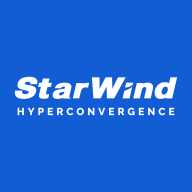


Scality RING and StarWind Virtual SAN are competing storage solutions designed for modern data management. StarWind Virtual SAN often has the upper hand due to its advanced features leading to higher satisfaction; however, Scality RING frequently scores better in pricing and reliability, offering significant value for investment.
Features: Scality RING provides robust scalability and geo-replication for large-scale, multi-site deployments. It supports multi-cloud environments and ensures data durability and management. StarWind Virtual SAN is known for high-performance storage in virtualized settings, offering speed and integrated support for hyper-converged infrastructures. It is appreciated for simplicity and easy integration with various scenarios, including hybrid cloud.
Room for Improvement: Scality RING can improve its deployment approach by reducing the need for specialized expertise to shorten deployment time. Its customer support could become more responsive to enhance user experience. Additionally, enhancing integration options with diverse software environments may increase its adoption. StarWind Virtual SAN could enhance its cost model to lower initial investment barriers, broaden integration capabilities with other platforms, and potentially simplify its pricing structure for better transparency.
Ease of Deployment and Customer Service: Scality RING uses a modular deployment approach, which may require specialized expertise, potentially extending deployment time. Its customer service is robust but can improve in responsiveness. StarWind Virtual SAN is praised for streamlined deployment with faster installations and less complexity. It also receives high marks for proactive and supportive customer service.
Pricing and ROI: Scality RING generally offers a predictable pricing model with lower initial costs, providing strong support for diverse workloads leading to high ROI. In contrast, StarWind Virtual SAN, with a higher initial investment, focuses on maximizing performance and reducing long-term costs, offering substantial ROI through improved performance efficiencies.
It does not require much management once you set up correctly, so it saves time, allowing an admin to focus on other work.
I think RING's ability to maintain predictable costs while providing scalable storage solutions impacts our budget by allowing us to pay only for capacity.
For instance, while the cost per gig on a block storage platform may be $2, it's $1.50 for NAS, and only $0.50 for object storage, leading to a remarkable 75% reduction in costs by utilizing the Scality platform.
Scality RING has reduced our operating costs.
We don't sell a lot of redundant servers, so it's not a massive ROI, but the ability to rely on their technical support and the software's ease of setup allows us to reduce labor costs and go to market competitively.
The cost benefits, as far as we consider, are much better with a StarWind VSAN solution, and the training requirements with the ease of administration simplify and reduce our administrator and professional services costs.
Regarding cost savings, for my client, it was about 20K USD for his specific use and as for extending capacity, StarWind made that process easy.
I would rate them an eight out of ten.
The support is done through email and is not that great, making it a very problematic area I've been dealing with for over four years.
Their technical support has been perfect lately, so I would give it a 10.
I've always received responses within the required timeframe, the answers were technically relevant, and there was follow-up—people called us back to check if everything was okay and if the ticket could be closed.
Individuals such as Peter Mikolastik really make a difference by saying, 'Come on, what is the problem? I will help you,' rather than just brushing things off.
Technically, when we have major issues in P1, they are very responsive and we can't say that we don't get a response.
Even in the instances where my technical team does not have the ability to manage or troubleshoot or resolve an issue, StarWind's technical team supports and resolves on our behalf very quickly.
They have some awesome guides online that show you exactly how to configure the product, how to do the initial setup, and you can speak with them directly who will be able to connect, verify your setup, run its parameters, and see exactly what's working and what is not, and adjust it, and they really help you with that.
When we set it up, they validate our settings and configurations to ensure we don't miss anything.
Pure Storage FlashBlade is scalable.
There are between 5 and 10,000 people using it in our organization.
Upwards, I think, almost unlimited by what we can imagine.
I've never had issues with scalability.
We are relatively well informed about their new features, what will be implemented in future versions, and the scalability of the solution.
I believe that scalability should be further improved, especially considering the possibility that environments may grow exponentially.
I have never needed to scale up or add additional nodes with StarWind Virtual SAN, but we have had to expand, and customer support has been excellent.
StarWind Virtual SAN's scalability is good, and I have had an easy experience adding more space to the system.
In case there is any issue with any blade, the data is moved to another.
It is a platform that is very stable at the customer level and does not generate incidents or blockages that you might encounter with standard storage solutions, where you can lose data.
I find that Scality RING is very stable because it allows for many maintenance operations without service loss.
There are factors that can cause Scality RING to become occasionally unavailable, but due to the system's resilience, it is capable of recovering or degrading gracefully.
In my experience, StarWind Virtual SAN is very stable, and I have never had a single instability issue.
It has been working for five years and the customer is still happy with it.
I ran it on a two-node Hyper-V cluster setup, and I didn't experience any unexpected crashes or major issues.
Technical support definitely needs significant improvement.
Its configuration should be easier.
One way Pure Storage FlashBlade can be improved is by having more compatibility between the FlashArray and FlashBlade.
Encryption and data security need improvement. We don't have a solution for customers who need confidentiality.
They should prioritize quality over timeliness to minimize customer disruptions and not force customers into a cycle of fixes that interfere with daily work.
What we are currently missing and will be demanding in the new tender is an additional external backup of all data, ideally on a simple system, to safeguard against any severe local incidents so that we still have the data protected elsewhere.
A more intuitive interface or an improved dashboard for monitoring the cluster would also be helpful, as it would facilitate performance tracking and help identify potential issues before they affect services.
There have been cases where not understanding exactly what's failing on the Virtual SAN has been an issue.
Limited feedback in the management GUI is the main area where I would like to see StarWind Virtual SAN get better.
The pricing of Pure Storage FlashBlade is expensive compared to other products I used from other companies in the past, but one benefit is that they have built-in ransomware protection.
Regarding pricing, it is okay; we needed exactly this in size, and the price was a lot lower than competitors, making it good for us.
Fortunately, in terms of the license, we are able to expand the disks without having to adjust the license.
In the end, it always depends on how much you pay for it.
Regarding setup costs and licensing, our initial experience is somewhat dated now as we made a comprehensive purchase, including hardware, software, and system setup, which Scality handled at the time.
The costs are acceptable and very competitive compared to other hardware-only HCI solutions.
I talked to the sales team, they gave me a quote with a perpetual license with the support and everything went through smoothly.
This is a great product and good support even you are using free version!
We can plug in many blades, and we can have data up to one terabyte.
The best features of Pure Storage FlashBlade include better throughput and better performance.
Pure Storage FlashBlade's scalability is one of the most valuable features, and importantly, it always works, allowing for seamless upgrades.
When a server is lost, the data is still accessible.
It is even better stored when there is only one copy on a system and there is a second copy on an immutability system, which is almost equivalent to backing it up on tape and taking it offline, making it completely inaccessible.
Scality RING has influenced our approach to scaling in different dimensions by providing a cost-effective solution for the tremendous amount of data we generate every day for each customer.
Thanks to its seamless integration with Proxmox, the implementation of high availability servers has drastically reduced downtime, which is crucial for our security-focused company.
StarWind Virtual SAN helps us keep customer satisfaction and provides the solutions we need without having to hire many IT specialists.
StarWind's storage virtualization and failover capabilities have made a difference for my clusters through uptime improvements, with zero downtime specific to server host maintenance or even maintenance of the StarWind software itself.
| Product | Market Share (%) |
|---|---|
| StarWind Virtual SAN | 6.1% |
| Scality RING | 3.9% |
| Pure Storage FlashBlade | 4.1% |
| Other | 85.9% |



| Company Size | Count |
|---|---|
| Small Business | 11 |
| Midsize Enterprise | 11 |
| Large Enterprise | 21 |
| Company Size | Count |
|---|---|
| Small Business | 3 |
| Midsize Enterprise | 1 |
| Large Enterprise | 12 |
| Company Size | Count |
|---|---|
| Small Business | 162 |
| Midsize Enterprise | 54 |
| Large Enterprise | 33 |
FlashBlade is the industry’s most advanced scale-out storage for unstructured data, powered by a modern, massively parallel architecture to consolidate complex data silos (like backup appliances and data lakes) and accelerate tomorrow’s discoveries and insights.
Scality RING is the scalable and resilient object storage solution designed for modern workloads, providing seamless data protection against evolving cyber threats.
Scality RING leverages S3 object storage to meet unpredictable demands with a patented MultiScale Architecture that offers limitless scalability across capacity, performance, and more. It delivers end-to-end cyber resilience with CORE5 for ransomware protection, while its cloud-style economics and intuitive management empower enterprises to accelerate AI initiatives and optimize cloud deployments. Its flexibility is ideal for service providers managing extensive data needs.
What are the key features of Scality RING?Scality RING is extensively implemented in backup solutions across industries, supporting platforms like Veeam and CommVault. It aids in storage expansion and management of large data volumes alongside multi-site architectures. While not leading in AI spaces due to performance constraints, there's potential with faster disk support. It's also used in archives, binary lakes, multimedia services, and AI data lakes.
StarWind Virtual SAN provides high availability and fault tolerance for virtualized environments without the need for dedicated SAN hardware. It allows for real-time replication between servers, shared storage for Hyper-V clusters, and enables vMotion and High Availability features for VMware vSphere. The solution reduces costs and leverages existing hardware while providing a scalable and reliable infrastructure. Valuable features include ease of use, scalability, top-tier support, hardware agnosticism, and the ability to use off-the-shelf standard servers to increase storage space. StarWind VSAN has helped organizations improve performance, data availability, and data security while reducing downtime and providing cost-saving storage options.
We monitor all Software Defined Storage (SDS) reviews to prevent fraudulent reviews and keep review quality high. We do not post reviews by company employees or direct competitors. We validate each review for authenticity via cross-reference with LinkedIn, and personal follow-up with the reviewer when necessary.